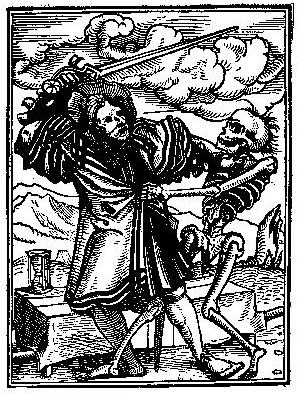|
Synopsis Of EVERYMAN: This morality play seeks to answer the important religious question: “What must a man do to be saved?” God sends Death to summon Everyman, who represents all mankind. Good and Evil will be tallied like pluses and minuses in an account book. The play is the story of Everyman's journey to this final reckoning. Along the way, Everyman tries to convince other characters to accompany him in the hope of improving his account. The other characters are also allegorical; that is, each character personifies an abstract idea. The conflict between good and evil is dramatized by the interactions between characters. The play shows us not only how every man should meet death but also how every man should live. Everyman is a dramatized allegory. An allegory is a narrative in which the characters and action, and sometimes the setting as well, have two levels of meaning. The first level is literal -- a man is going on a trip. The second level is symbolic -- Everyman’s life is a journey from birth to death, and every man makes this same trip. An allegory must make sense at both levels. All of the literal pieces will fit together to tell a story -- what happens. In addition, all of the symbolic pieces will fit together to teach a moral -- what the story means. For example, John Bunyan’s Pilgrim’s Progress is an allegory teaching the doctrines of Christian salvation. The hero, named Christian, is warned by Evangelist to flee the City of Destruction and seek the Celestial City. En route Christian encounters such characters as Faithful, the Giant Despair, and Mr. Worldly Wiseman. He passes through places like the Slough of Despond, the Valley of the Shadow of Death, and Vanity Fair. On the literal level, this is an exciting adventure story. On the symbolic level, however, each adventure also teaches a moral lesson.
Activity One: In order to understand both levels of the play, you need to know the meaning of the following words. Define each word.
Activity Two: The following questions ask you to recall the characters and events of the play -- what happens at the literal level. 1. Why does God send Death to summon Everyman? 2. How does Everyman react to the summons by Death? 3. The author of this play used deliberate repetition to drive home major points. In what way do Everyman’s encounters with Fellowship and Kindred follow a similar pattern? 4. What happens when Everyman asks Goods to accompany him? Why does Goods think that his presence would adversely influence God's judgment of Everyman? 5. Why is Good Deeds at first unable to accompany Everyman? 6. How does Knowledge help Everyman on his journey? 7. Explain how the play supports the idea that knowledge of one's sin is necessary before one can truly repent. 8. How does the order in which Beauty, Strength, Discretion, and Five Wits abandon Everyman parallel the process of aging? 9. Who follows Everyman into the grave? 10. What does the weakness of Good Deeds reveal about the
way Everyman has led his life? Activity Three: Prepare a plot diagram for the play. Include brief notes indicating the order in which each character meets with Everyman and what happens during that meeting. For example, the first character who enters is Death. Everyman tries to talk Death out of taking him, begging for more time, and finally even attempting bribery. And so on. Activity Four: Consider how you might use costume to identify each of the following major characters. List each character, describe the costume you have chosen, and explain how each character’s costume and behavior might appropriately personify that abstract idea.
For example, Good Deeds could be costumed as a Girl Scout because of the values supported in the Girl Scout Pledge: “On my honor, I will try: Thus, a Girl Scout is supposed to be honorable, religious, patriotic, helpful, and law-abiding. Line 3 of the pledge specifically promises to do good for others, but the other associations are also admirable. This is why a Girl Scout costume is appropriate to personify Good Deeds. For the Test: Morality plays often dramatize man’s struggle to avoid vice and seek virtue. Make sure you can define each of the following abstract terms on your own paper and give an example. You might look back at your MTV video notes.
CREATIVE WRITING: Select one of the following assignments. 1. Rewrite the story of Everyman in one of the following forms: a children’s book, a fable, a fairy tale, or a modern short story. Design a frontispiece or cover for your creation which will show the summoning of your Everyman/Everywoman. You may include his/her companions, but you must include a sketch of your character, a title, your name, and a brief teaser to "seduce" readers into reading your version. 2. Write your own morality play, basing it upon contemporary images and moral concerns. Follow correct play form, as demonstrated in Everyman. Name your protagonist allegorically and make sure your play has a moral. Do not merely personify some vices and virtues, having them converse inanely -- create a lesson for a modern Everyperson. 3. Write a morality play called Every Student. Personify
the problems Every Student faces during his journey to Graduation
and the qualities that help him overcome those problems. Teach
a moral by showing how Every Student can succeed. |
Updated 15 June 2019.
 The
Summoning of EVERYMAN:
The
Summoning of EVERYMAN: